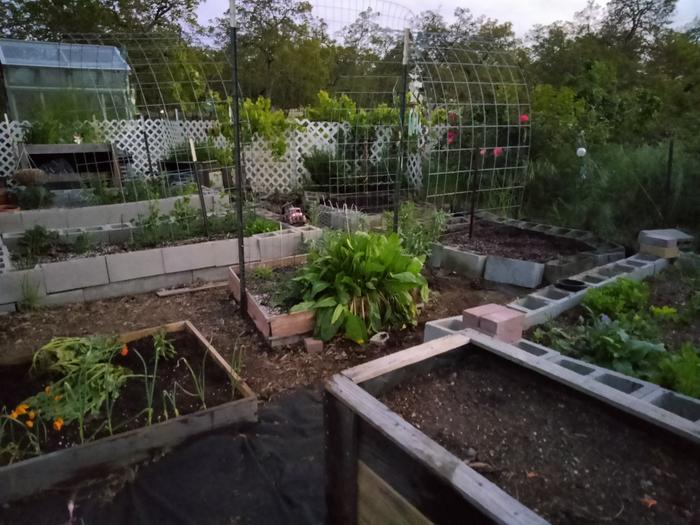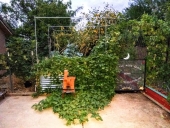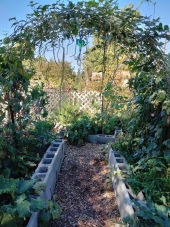
 15
15




“We can complain because rose bushes have thorns, or rejoice because thorn bushes have roses.” — Abraham Lincoln
 5
5




 10
10




This is all just my opinion based on a flawed memory


 10
10




- Tim's Homestead Journal - Purchase a copy of Building a Better World in Your Backyard - Purchase 6 Decks of Permaculture Cards -
- Purchase 12x Decks of Permaculture Cards - Purchase a copy of the SKIP Book - Purchase 12x copies of Building a Better World in your Backyard
 2
2




 7
7




Timothy Norton wrote:Where a item/design/plan might work for some folks in their particular location, it may not work for others.
I wouldn't frame this as a defeat to beat yourself up over, but rather an experiment that has concluded. Like all good scientists, now it is time to move onto the next experiment!
Those chickens do look pleased haha.
 9
9




“We can complain because rose bushes have thorns, or rejoice because thorn bushes have roses.” — Abraham Lincoln
 5
5




 8
8




Zone 6, 45 inches precipitation, hard clay soil




 4
4




May Lotito wrote:Similarly, hugel was what led me to Permies and I built a few in 2019 which, in retrospect, I made many mistakes building. Well the hardwood logs break down much slower than I thought. And the optimism of fertility and drought resistance comes with buried wood made me to neglect caring for those beds as with other growing areas. Now I reserve the spots for wildflowers since they are the only things survived.
Here I dug up one oak log from the 2019 hugel bed. It's only rotting on part of the surface after five years.
Your big heap of soil looks quite dark and fertile. Are the logs rotton down very well too?
 11
11




And sneaky. And they know what they like, which is to dig for bugs and treats in dirt.My son thought I would use the soil/wood that was removed from the top of the hugel in the raised beds. I want to, but it's loaded with weeds. Then it came to me. I had him dump it in the chicken yard. They will enjoy digging through it. Eating and killing all growing things. I can remove the wood as it shows up, and harvest the amazing soil as they process it for me. ... Not only can chickens fly, some better than others, but they are resourceful.
Visit Redhawk's soil series: https://permies.com/wiki/redhawk-soil
How permies.com works: https://permies.com/wiki/34193/permies-works-links-threads
 7
7




Fish heads fish heads roly poly fish heads
 4
4




Jay Angler wrote:
Permaculture solutions don't work for every situation. Some don't scale up. Some don't scale down. Some simply have ecosystems they work in, and ecosystems where they're so-so, or a downright failure.
 9
9





“We can complain because rose bushes have thorns, or rejoice because thorn bushes have roses.” — Abraham Lincoln
 6
6




Where there is Liberty, there is Christ!
 2
2




“We can complain because rose bushes have thorns, or rejoice because thorn bushes have roses.” — Abraham Lincoln
 8
8




from https://permies.com/t/184385/Venting-hugelsRebecca Norman wrote:
Jen Fulkerson wrote:Maybe because I have to keep rebuilding it, maybe because we get so little rain, what ever the reason my hugel is just another garden bed for me. I have to water it just as often as all my other gardens, and being short, makes maintaining it a challenge. It's my least favorite garden bed to be honest. I much prefer the raised bed hugel beet. They are super productive, and easy to maintain. It's easier to water as well.
What is the difference between your hugel and your raised bed hugel beet? (According to hugel things I've seen hugel is just short for Hugelbeet or something, and hugel bed is the English for Hugelbeet, and the original Hugelbeets are raised, but some people have innovated sunken hugel beds for dry climates. But I actually have no practical experience, have only read and watched.)
Visit Redhawk's soil series: https://permies.com/wiki/redhawk-soil
How permies.com works: https://permies.com/wiki/34193/permies-works-links-threads
 5
5




Jay Angler wrote:"
I worry that some of the language purists, will only consider it a true "hugelkulture" if it's large enough and tall enough to not need any irrigation. I think that's part of where terms like hugelbeet and hugelbed may have arose.
 2
2








Jen Fulkerson wrote:Last year I used a PVC pipe for a stake for my zucchini. Since it was there I filled it when I watered. I have never had a healthier more productive zucchini.
 1
1




Jen Fulkerson wrote:Dan I really like my raised bed hugel beets. They have been working quite well for me. Maybe because most aren't raised very high, and they have all the good stuff in the ground??? That being said I'm going to add a bunch of ollas, and PVC pipe next to my more thirsty plants. The ollas to keep consistent water. Last year I used a PVC pipe for a stake for my zucchini. Since it was there I filled it when I watered. I have never had a healthier more productive zucchini. So I'm going to try it with my tomatoes, and experimente with a few others. It's a catch 22. I hate to use plastic in my garden. At the same time I work full time, have chickens, dogs, cats and other interests. So even though I love my garden, and actually enjoy watering, spending hours after work everyday in the summer can be a bit much, so it may be worth a compromise.
In the south when the wind gets to 75 mph they give it a name and call it a hurricane. Here we call it a mite windy...
 4
4




“We can complain because rose bushes have thorns, or rejoice because thorn bushes have roses.” — Abraham Lincoln
 8
8




 4
4




 2
2




Mediterranean climate, hugel trenches, fabulous clay soil high in nutrients, self-watering containers with hugel layers, keyhole composting with low hugel raised beds, thick Back to Eden Wood chips mulch (distinguished from Bark chips), using as many native plants as possible....all drought tolerant.
 2
2




“We can complain because rose bushes have thorns, or rejoice because thorn bushes have roses.” — Abraham Lincoln

|
See where your hand is? Not there. It's next to this tiny ad:
Learn Permaculture through a little hard work
https://wheaton-labs.com/bootcamp
|





